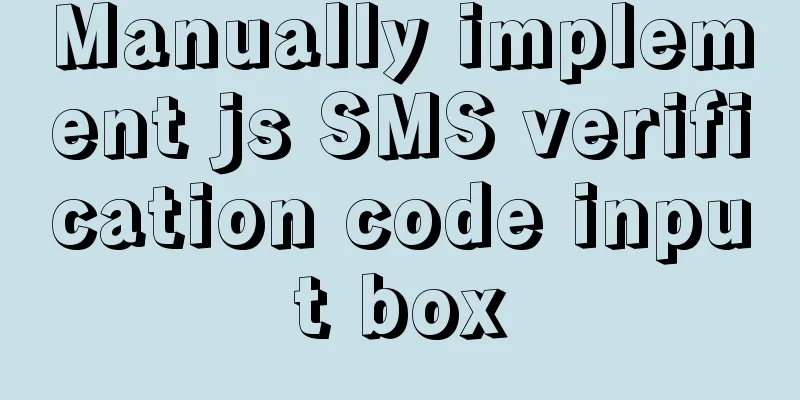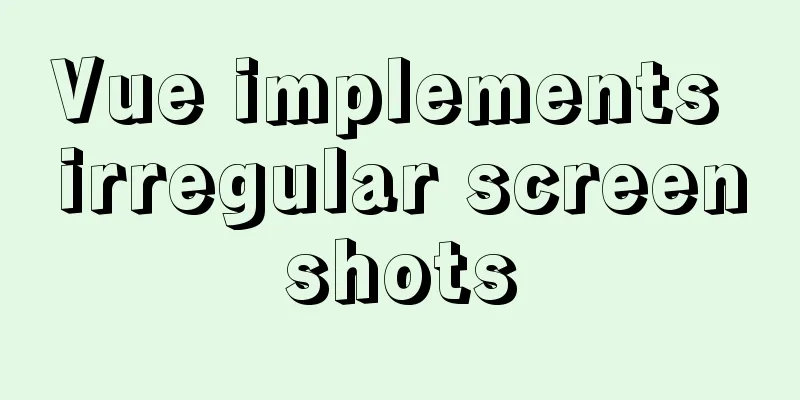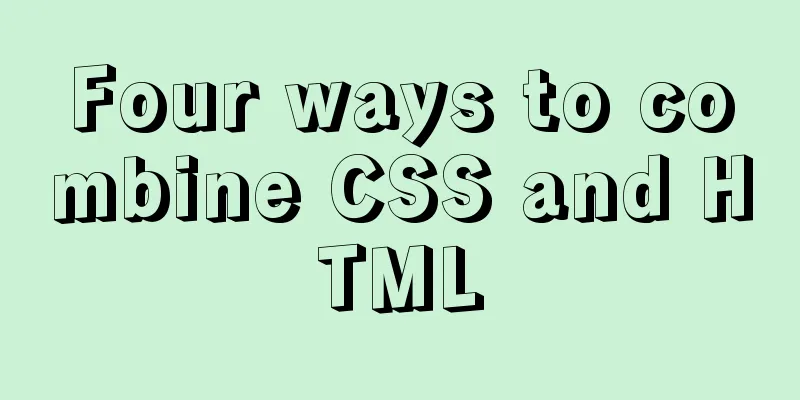Manually implement js SMS verification code input box

PrefaceThis article records a common SMS verification code input component for the front end that I manually implemented, and the process of gradual optimization from demand to implementation. text1. Demand Analysis First, let’s take a look at the renderings.
First, when the page is loaded, the input box gets the focus. When the user enters a number, the focus automatically jumps to the second box. When all four boxes are entered, the submission request is simulated. Here, a pop-up box prompt is used to output the input verification code content. Requirements outside the main process: Only numbers can be entered in the input box, not letters. If a non-numeric type is forced to be entered, the verification code entered when the withdrawal key is pressed will be cleared and the current focus will jump to the first input box. 2. Complete code implementation. The general idea is that when the page is loaded, add the autofocus attribute to the first input box to let it automatically get the focus, and then listen for keyboard click events. When the keyboard is pressed, determine whether the current key is a numeric key. If not, the current input box is set to empty and the focus is still in the current input box. If it is a number, determine whether there is a number in the previous input box. If not, jump the focus to the previous empty input box. Otherwise, enter the current input box and move the focus to the next input box. The focus is implemented through a pseudo-class of the input box. When the input length is 4, the numbers in each input box are concatenated into a string and prompted through a pop-up box.
<!DOCTYPE html>
<html lang="en">
<head>
<meta charset="UTF-8" />
<meta http-equiv="X-UA-Compatible" content="IE=edge" />
<meta name="viewport" content="width=device-width, initial-scale=1.0" />
<title>Document</title>
<style>
.check-div {
width: 400px;
height: 600px;
margin: 100px auto;
border: 1px solid slategrey;
text-align: center;
}
h1 {
font-size: 24px;
}
.input-div {
margin-top: 100px;
}
input {
margin-left: 5px;
text-align: center;
width: 50px;
height: 50px;
border: none;
/* Note that the default outer border attributes should be modified here, without border*/
outline: 1px solid black;
}
input:focus {
outline: 2px solid #3494fe;
}
</style>
</head>
<body>
<div class="check-div">
<h1>Please enter the verification code</h1>
<div class="input-div">
<input
type="text"
class="inputItem0"
data-index="0"
maxlength="1"
autofocus
/>
<input type="text" class="inputItem1" data-index="1" maxlength="1" />
<input type="text" class="inputItem2" data-index="2" maxlength="1" />
<input type="text" class="inputItem3" data-index="3" maxlength="1" />
</div>
</div>
<script>
var inputArr = document.getElementsByTagName("input");
window.addEventListener("keyup", (e) => {
let curIndex = e.target.getAttribute("data-index"); //Get the index of the current input //If you click BackSpace, delete all here if (e && e.keyCode == 8) {
console.log(22222222222);
for (let j = 0; j <= 3; j++) {
inputArr[j].value = "";
inputArr[0].focus();
}
return;
}
console.log("e.keyCode", e.keyCode);
//If the input is not a numberif (!(e.keyCode >= 48 && e.keyCode <= 57)) {
console.log(1111111111);
inputArr[curIndex].value = "";
return false;
}
//Traverse the array values and concatenate them into a verification code string var str = "";
for (let j = 0; j <= 3; j++) {
console.log(inputArr[j].value);
str += inputArr[j].value;
}
var nextIndex = Number(curIndex) + 1;
//When judging that there are not enough four-digit verification codes if (curIndex < 3 && str.length < 4) {
for (let i = 0; i <= curIndex; i++) {
// Check if the previous one is empty or not, if yes, adjust the focus to the front and put the input back to the front, otherwise jump to the next one if (!inputArr[i].value) {
inputArr[curIndex].blur();
inputArr[i].value = inputArr[curIndex].value;
var index = i + 1;
inputArr[index].focus();
inputArr[curIndex].value = "";
return;
} else {
var nextIndex = Number(curIndex) + 1;
inputArr[nextIndex].focus();
}
}
} else {
alert("The verification code submitted is " + str);
//When a four-digit verification code is entered, a verification code request can be sent, etc.}
});
</script>
</body>
</html>SummarizeThis is the end of this article about manually implementing the js SMS verification code input box. For more relevant js SMS verification code input box content, please search 123WORDPRESS.COM's previous articles or continue to browse the following related articles. I hope everyone will support 123WORDPRESS.COM in the future! You may also be interested in:
|
<<: Zabbix monitoring solution - the latest official version 4.4 [recommended]
>>: Introduction to the difference between on and where conditions in MySQL left join operation
Recommend
A brief discussion on the specific use of viewport in mobile terminals
Table of contents 1. Basic Concepts 1.1 Two kinds...
Vue improves page response speed through lazy loading
Table of contents Overview What is lazy loading? ...
The grid is your layout plan for the page
<br /> English original: http://desktoppub.a...
Quickly solve the problem of slow Tomcat startup, super simple
Today I helped a classmate solve a problem - Tomc...
MySQL 5.7.27 installation and configuration method graphic tutorial
MySQL 5.7.27 detailed download, installation and ...
Native JS realizes the special effect of spreading love by mouse sliding
This article shares with you a js special effect ...
Deploy the Vue project on a Linux server
Case 1 vue-cli builds the vue3 project, uploads t...
React tsx generates random verification code
React tsx generates a random verification code fo...
Multiple solutions for cross-domain reasons in web development
Table of contents Cross-domain reasons JSONP Ngin...
Understanding of CSS selector weight (personal test)
Copy code The code is as follows: <style type=...
Mac+IDEA+Tomcat configuration steps
Table of contents 1. Download 2. Installation and...
jQuery plugin to achieve seamless carousel
Seamless carousel is a very common effect, and it...
Detailed explanation of HTML page embedding video and JS control switching video example
First, the HTML code to embed the video in the pag...
Docker Nginx container and Tomcat container to achieve load balancing and dynamic and static separation operations
Download Tomcat8 image [root@localhost ~]# docker...
Solve the problem that the CentOS7 virtual machine cannot access the Internet and set up the CentOS7 virtual machine to use a static IP to access the Internet
I was playing with CentOS in a VMware virtual mac...










